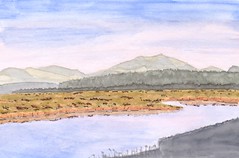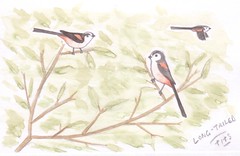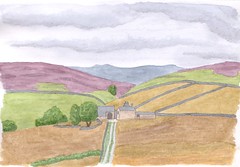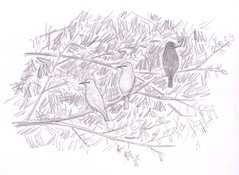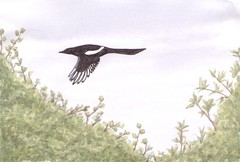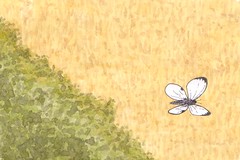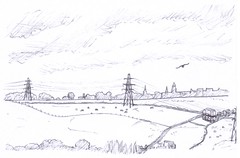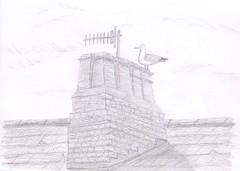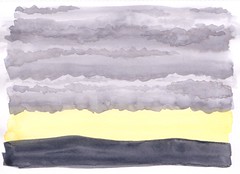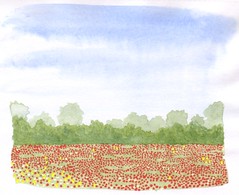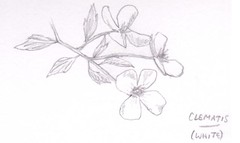Monday, December 26, 2005
Calm and peaceful
Well, even with this week's events, I've still managed to keep an eye on the natural world. From the 2 magpies on the hospital roof on Monday (very appropriate - 2 for joy) to a sparrowhawk zipping between the houses on Wednesday as I went to visit Deb. A very Christmassy robin on the birdfeeders in the garden was also much appreciated.
Apart from a wish that there was more to see in the garden at 4am (1 week old baby - nuff said), the thing that has struck me this week is the large number of collared doves about, hence the sketch. There's been up to 6 of them roosting, and generally loafing, in the hawthorns at the back of the house. Are they this year's young? Are collared doves not very territorial in winter (or ever)?
Whatever it is, it seems to have been a good year for them so far. There hasn't been this many around for some time, and from my observations, it seems to be the same all over the local area. I find the song of the collared dove very calming so it looks like it might be a calm year ahead.
Hopefully, that will be true for everybody. A peaceful 2006 to you all.
Thursday, December 22, 2005
A new arrival
My brother put it perfectly "She's beautiful...are you sure she's yours?"
She is mine - evolution in action!!
Friday, December 16, 2005
Good for the soul
I drive past here every morning, there are shorter and faster ways to work, but none that are so good for the soul. Remembering a quote from Rachel Carson "Those who dwell among the beauties and mysteries of the Earth are never alone or weary of life", I had to stop the car to dwell on this view.
On the way home a less impressive dusk was made special by a red kite quartering the fields by the road.
Sunday, December 11, 2005
Oh Christmas Tree
I like pine cones, and pine trees too. I've started a few sentences with 'I like...' on this blog. That's because I find so many things I do like, and it's much better than 'I hate...'. Most of my 'I like' things are running simultaneously in my head for a while before I condense them into a sketch and an entry.
Well, back to pines. I know lots of folk aren't keen, thanks to the Forestry Commission planting huge swathes of pines, in the place of more native plants. These plantations are often wildlife deserts as well, which doesn't improve the public's perception of them. But none of this is the fault of the pine.
The trees and cones themselves are a feast for the senses. The texture of the cones and the scent of the needles are so unusual yet pleasant, and the shape of the young trees instantly brings Christmas and goodwill to mind (I'm not big on pesto though). That's why our Christmas tree is plastic, goodwill to all pine trees at least.
Wednesday, December 07, 2005
Against the clock
No worries though, I often spend too long on the fiddly details, quick pics will add a bit more looseness and spotaneity. The last entry was a quick one. Well, at 5 minutes, this oil pastel sketch tops it. World record attempt to follow.
As for the subject matter, I like hedgerows. They're so varied at the moment, some are bare, some are still in leaf. They look so different in different lights. I just love that low winter sunshine, it gives the colours such a zing. And they're so good for wildlife, robins in full song, blackbirds clucking away and the odd redwing over. This bit of hedge is near Knottingley, and in summer will probably provide perches for singing corn buntings.
Thursday, December 01, 2005
Room with a view - in colour
Anyway, after a bit of snow earlier in the week, Tuesday was glorious. If anything, the view looks better here than it did under grey July skies. I dare say this view will appear here again, unless they point my room in a different direction, so watch this space.
Tuesday, November 29, 2005
A sky full of snow
The sketch was done with watersoluble 8B pencil, and smudged with licked fingers (my son, Nathan, makes a similar looking mess on clean walls). It was good for a sky that looked full of snow. Confirmed when we had our first snow and sleet of the winter later in the day.
Monday, November 28, 2005
Ewe two
Well here's how I've progressed with sheep, this one has an air of wildebeest about the face. Nonetheless, wildebeest are closer to home than kangaroos, both geographically and genealogically.
Tuesday, November 22, 2005
The view from the cliff
It was about an hour before sunset and the sky was just starting to go pink. The northern edge of the peak district was soft shades of grey and the foreground (Kippax village) was autumnal shades of brown and green. I feel very privileged to live so close to such a view. Breathtaking.
Saturday, November 19, 2005
Fungal foray
Because he was a fungi (fun guy)!!
Sorry.
This bracket fungus looks like it might be on a stump in the middle of some ancient forest. In fact, it was on the edge of one of those raised beds, planted by the council, next to a row of shops. There's a chip shop and a hairdressers not 30 feet away. Proof that nature's right under our noses and it gets on and does its own thing despite us.
Tuesday, November 15, 2005
Despite grey skies
This sketch cheers me up because, despite grey skies, some of the colours are almost spring-like, courtesy of school's nice, bright coloured pencils
Saturday, November 12, 2005
Flower Show
There isn't huge profusions of flowers, but they are there. I expect to see a few dahlias and the solanum always manages a good show well into November. What about gazania, delphinium, impatiens, red clover and gorse though? All still in flower as we near November's third week. I've never known a year like it. Is it global warming? Is it just a warm autumn, due to chance? Maybe it's down to the protection afforded by the microclimates of towns and villages hereabouts.
I hope it's just part of the wonderful seaonal variation that we get in Britain. The variation and lack of extremes that makes me so glad to live in this temperate little corner of the world. I'll stop there, before I start singing 'Jerusalem'.
Sunday, November 06, 2005
Counting kestrels
I once read a letter in a wildlife magazine from a bloke who claimed to have driven from Devon to Scotland and only saw one kestrel all journey. He cited this as evidence that kestrels were struggling. All birds need all the help and attention they can get but I think he was either a poor kestrel spotter or a very conscientious driver. My record count for a single journey is four, over the eleven miles to work. He should have driven through Leeds.
This is the female of the pair that holds territory at the end of the road, where the housing borders onto open fields. She was sat on the lamp-post this morning, presumably looking for a meal to scurry by.
Tuesday, November 01, 2005
The Lime Avenue
Richard Bell describes it brilliantly, and so much better than I ever could, “there's autumn colour around, especially in the ashes, rowans and horse chestnuts, which glow as if they'd been illuminated from within but there's also plenty of dull drab green - the colour of waxed jackets and hiking trousers.” (Click here to see the full entry with illustrations.)
You can add ‘lime trees’ to that quote. The sketch is my impression of the Lime Avenue, an impressive stand of mature lime trees, spectacular and stately in the watery sunshine of late October.
Tuesday, October 25, 2005
The Alternative Bird Garden
After all that, we didn’t go to the bird garden today, we visited the adjoining deer park and went around the formal gardens. The red deer are well into their rutting season, with four impressively armoured males laying claim to a small territory, each one apparently centred on one of the equally impressive oak trees that abound in the deer park. With the sound of bellowing stags and a hint of mist in the air, we could have been in a highland glen rather than a half hour drive from Leeds city centre (you just had to put the distant cries of the whooping cranes, from the bird garden, out of your mind). You can certainly see why Landseer was so inspired by the stag.
In the formal gardens, the least contrived wildlife spectacle was in full flow – migration. Redwing were streaming over, there must have been four to five hundred, dropping into the trees to feed. This thrush is one of my favourite winter visitors, they arrive from Scandinavia in large numbers. The redwing joined good numbers of titmice, starlings and a single siskin. In the surrounding fields, there were an equally good number of fieldfare – another Scandinavian migrant thrush. All were feeding like their lives depended on it, which they probably do. So maybe we did go to the bird garden after all.
Tuesday, October 18, 2005
Who's laughing now?
I finally caught up with the gull yesterday evening, got the adrenaline rush, watched it for half an hour then went home for tea. I was very happy.
The other upside to this tale is that I've basically spent a week watching flocks of common and black-headed gulls. I've improved my skills, I know common and black-headed gulls in all variations of winter plumage, and from all angles, in flight and on the ground (not that you'd know it from my sketch, perhaps). I've spent more time than I normally would simply being closer to nature. There are worse ways to spend your time.
Tuesday, October 11, 2005
The Therapeutic Jungle
On more natural matters, the trees (outside!) are starting to colour up nicely, with definite tinges of gold and rust beginning to appear. This seems quite early to me, I just hope we don’t get any strong winds for a few weeks so we get to see the colours develop. Maybe the colour coming early will give it a better chance before the autumn winds really get started. It bodes well at present.
Talking about plants and jungles, congrats to Castleford Tigers Rugby League, for roaring back to the Super League, through the play-offs on Sunday. Sorry for the awful pun and the tenuous link (the Tigers play at ‘The Jungle’, although it’s still Wheldon Road to me).
Wednesday, October 05, 2005
For the record
Mistle thrushes have been a peripheral presence ever since I started thinking about them around a fortnight ago. It seems like thinking about them has made them appear. Everywhere I go, a mistle thrush hops across the path, flies overhead or rattles from the depth of a bush. I'm now going to start thinking about fox sparrows on my bird feeders....
Saturday, October 01, 2005
A different kind of flyover
From late September through to early March, a small flock of 30-60 Canada geese fly directly over our house from... er, somewhere to... erm, somewhere else. They usually fly south in the morning and north in the evening, but sometimes it's the other way round and today they flew south both morning and evening?! There's plenty of fields around to feed in, not that I've ever seen them during the day, but I don't know of anywhere in the vicinity that they might roost on dark nights.
To be honest, I don't know where the geese go and I don't care. Just like I don't care they're an introduced species that some folk don't care for, and I don't care it's not Islay or north Norfolk numbers. That's because each time I hear them, I still excitedly rush to the window or door, hoping to catch a glimpse of the geese flying over. My spirit flies with them.
Friday, September 30, 2005
Sheffield Thursday
The sketch was done on the back of my delegate folder, using a free pen that was in my delegate folder. I made sure they didn't go to waste.
Monday, September 26, 2005
Rosemary and lamb
Still, this was better than my go at the victorian-style lamp post and municipal shrubs, from Staples car park, or my last resort - drawing the blower fitting from my car dashboard. The last one had a Nobbsian look about it, but not as good, obviously (follow the link - right - to Michael Nobbs' site to see how it's done properly).
Back to unnatural history matters, we went for a walk round the block last night and it was interesting to see a rosemary bush still in flower so late in the year. Ours is long over and done with flowers. Along with the memory of the diascia we managed to overwinter, not once but twice, it just goes to show how gardens can form such individual microclimates.
Monday, September 19, 2005
The UK's number one...
I like them being common, I see lots of them every day in and around the fields on my way to work. There's even a pair that nest in the laurel bushes on one of Leed's busiest roundabouts - the Gyratory, too good a name for just a roundabout don't you think? I like the fact that you can identify them from a mile away, on the ground or in flight, thanks to all those white flashes. I just wish that, at half past five in the morning, they'd sing a little further down the street.
Sunday, September 11, 2005
Panda food
Deb bought the bamboo when it was only 2 feet tall, about 7 or 8 years ago, and at £5 we thought it was a bit pricey. What a bargain it turned out to be. It grew to around 8 feet tall and we've split it to make new plants several times since then. We've got a few ourselves and we've given a few away as well.
The bamboo and its offspring have done a great job of screening next-doors' dilapidated fence. It hasn't done much for the wildlife though - unless we get any passing pandas.
Sunday, September 04, 2005
Mists and mellow fruitfulness
Talking of robins, one of this years’ young robins has been a regular in the garden for the last week, getting ever more red-breasted. It’s looking well on the food we’ve been putting out for it, bags of special robin food from Swillington Nurseries. It’s the best place to buy feeder food as well, just the job for our new birdfeeders. We’ve just replaced our old feeders with some nice new ones from the RSPB shop at Fairburn Ings (I get discount because I’m a volunteer - at a local mine reclamation site that’s going to become a RSPB reserve eventually, and more of that another day).
The greedy greenfinches certainly seem to approve, there’s never less than a couple on the feeders at any one time. There are plenty of collared doves picking up the dropped seed too, I’ve seen up to eight in and around the garden recently, so a good breeding season for them then. The rarest visitor lately has been a willow tit, what a great bird to see in our garden, having never seen one nearer than 5 or so miles from Garforth. Those new feeders are doing the trick.
Monday, August 29, 2005
Buzzards from my bed
At the front of the house was a beach, flanked with rocks. There must have been a dozen species of seaweed of all shades of green, brown and red. It was swarming with crabs the size of your thumbnail. There was the usual assortment of waders, gulls and wagtails, plus the odd heron or two, and on calm high tides grey seals popped their heads out.
At the back was scrub and farmland, with buzzards and kestrels often in view. One morning I even saw two buzzards flying over the beach, from my bed – I shall have to start a ‘bed list’. Ravens were feeding in the sheep paddocks, and in these days of falling starling numbers, it was good to see around two hundred sat on the telephone wires. In the evenings, four to five hundred greylag geese could be spectacularly seen and heard coming in to roost on the nearby lakes.
A moving part of the holiday for me, was to visit Shorelands at Malltraeth, the home of the late artist, Charles Tunnicliffe. For those of you that don’t know, he was the original illustrator of ‘Tarka the Otter’, and he also illustrated the ‘Dig for Victory’ campaign posters and lots of the nature ladybird books, but his first love was birds. I felt privileged to see where he lived and painted, it has the most amazing view overlooking the Cefni estuary. Equally impressive are his original paintings at Oriel Ynys Mon, the museum built principally, I suspect, to house Tunnicliffe’s work, despite a local campaign in the late 80’s to prevent what was then seen as a waste of municipal money. Anyway, the museum is more than that now, housing displays reflecting all aspects of Anglesey life. Tunnicliffe’s art is breathtaking, all the more so as he never intended it to be displayed, it was done for pure pleasure. I hope the campaigners now see its’ worth.
Follow the link to see my Anglesey Sketchbook.
Saturday, August 20, 2005
Long-tailed Tits
However, there is an upside. The site is surrounded by mature trees and hedgerows, and at our end their is a small area of scrub and low woodland. The birds and insects love it.
I try to go along the footpath between the back of the house and this area regularly, just to see what's about. I have to be careful not to loiter so I don't look like a peeping tom. Nathan helps me here, when he's with me I look much less suspicious.
We walked past during the week and were treated to a flitting fly-past by a family party of long-tailed tits. These are one of Deb's favourite birds, and I can see why. They're like a fluffy pom-pom on a lolly stick of a tail, and their contact calls can only be described as a purr. I only wish we saw them in the garden more often.
Friday, August 12, 2005
Dark Peak
The Dark Peak is predominantly acidic peat moorland overlying gritstone, which pokes out to form rocky outcrops. The dominant plant is heather. This is particularly impressive about now, colouring whole hillsides a purplish hue and doing so on a huge scale. Otherwise, the only obvious sign of life is the red grouse, constantly calling ‘go-back, go-back’, with the occasional ‘seep’ of a meadow pipit. On an overcast day like today, with a blustery wind, this is an evocative place.
After doing some sketching, I drove down into the wooded valleys and ate my dinner at Fairholmes, overlooking Ladybower reservoir. With tits on the birdfeeders, nuthatches calling in the trees, tame ducks taking crusts and walkers and cyclists setting off/coming back, it was pleasantly busy (and warm) by comparison with the moor tops.
(I even made it home in time to see Shane Warne take his 600th test wicket.)
Thursday, August 04, 2005
Blacktoft Sands
There were all the birds you’d expect to see here, dunlin, ruff, redshank, greenshank, lapwing, plus a few Blacktoft specialities, avocet (of RSPB logo fame), bearded tit and spotted redshank, but no marsh harrier – maybe a bit windy for them today. There was the added bonus of a spoonbill, unusual enough, however this bird had been ringed (i.e. had plastic identification rings put on its legs) as a chick in Holland two years ago, so a bit of life history to add interest.
I was glad of a few years of birding experience to identify the many wading birds present. Present in all stages of plumage, summer, winter, adult, juvenile, and all points in between. So I felt for a mum with her 3 children, trying to identify the birds when she couldn’t even understand the order used in her field guide (divers, grebes, shearwaters, etc.) – a free gift for new members of the RSPB! You do learn the crazy taxonomic order over the years, but it doesn’t exactly encourage newcomers or the young. In future, I’ll be far less scornful of field guides ordered by size, colour or habitat.
Click on the link the see the other sketches I did today – Blacktoft Sands Sketchbook.
Monday, August 01, 2005
Starlings
Sunday, July 31, 2005
1 for sorrow, 2 for joy, 18 for…
Don’t get me wrong, I like magpies, they’re smart looking birds and they rattle with attitude. I’ve noticed a couple of ‘SOS’ car stickers around Leeds. SOS stands for Save Our Songbirds, an unpleasant campaign or organisation that promotes the destruction of corvids, like magpies, and birds of prey, under the guise of protecting the ‘songbirds’ whose chicks they eat. In reality, it’s gamekeepers, pigeon fanciers and the gullible, trying to put a respectable front on killing for their own benefit. I say 'campaign or organisation' because I don’t know which it is. Try searching for it or them on the internet, there isn’t even a website. Strange.
Magpies can be predators, live with it. Magpie numbers respond to prey (songbird) numbers, not the other way round. High magpie numbers is good, it means that songbird numbers must also be high, and vice versa. The percentage of chicks eaten will always be about the same. Songbird numbers are more affected by loss of suitable habitat.
At work, a couple of weeks ago, I was looking out of the window and counted 18 magpies on the field. Every time I see magpies I subconsciously say the rhyme, even though I only know as far as ‘4 for a boy’. Maybe it’s ‘18 for a successful breeding season’.
Tuesday, July 26, 2005
Mr McGregor's Garden
Obviously, all of the gardens are well kept and many offer ideas for our own ideal garden, but there was one garden that stood out. Situated in a part of the village that looks like it is of post-war construction, and generally looks less well cared for, the front garden looked ordinary enough with marigolds, petunias and a neat lawn, but the back garden was the surprise. It was like stepping into Mr McGregor's garden, of Peter Rabbit fame, row upon row of regimented vegetables, carrots, cabbages, beans, lettuces and so on. At the end of the garden was a ramshackle greenhouse, full of tomatoes and cucumbers. It brought back many happy memories of my grandad's vegetable patch.
As I drove into Barwick at the end of last week, a large white butterfly flitted along the hawthorn hedge, next to the cornfield. I thought of Mr McGregor's cabbages as his garden isn't more than 200 yards away, and because they aren't called 'cabbage whites' without reason. Fortunately, he was going the wrong way.
Wednesday, July 20, 2005
Taxonomy by Nathan
In reality, we counted dandelions, plantain and white clover because that was all they could recognize easily (after instruction) and it was all that was present in sufficient quantity to require quadratting to estimate numbers.
Whilst they were counting , I scanned the taller vegetation for anything interesting. Having read the bit on ladybirds in this months’ BBC Wildlife magazine, I was pleased to find a 2-spot ladybird. In my ignorance I thought I’d found a rarity, but the magazine told me it was ‘common and widespread’. Not in my garden, I’m sure I’ve only seen one on two or three occasions. I’ll certainly look more carefully in future.
Nathan will help me look, he’s interested in all things living, an interest I intend to fuel. At 20 months he’s already got a taxonomy system that would put most of those up to Linnaeus to shame. Two legs is a ‘quack-quack’, four legs is a ‘doggy’, six or more legs is a ‘spider’ unless it flies off, then it becomes a ‘bee’. Next stop, Cladistics Department at the Natural History Museum.
Monday, July 11, 2005
Room with a view - Thursday
After the awful events of Thursday, I just didn’t know what to say or do. Everyday folk, like me, just have to get on with it or bombers achieve what they set out to do.
For a few minutes, I escaped into the landscape, this is the far view from my window at work. Drawn with a black biro left by one of the kids on cartridge paper, it’s fairly pastoral, considering the fact that I work at an inner city school. The tallest building on the horizon is Morley Town Hall, I believe.
(Read Simon Barnes' column from the Times on Saturday, about the solace to be gained from nature).
Room with a view - Scarborough
We didn’t have a sea view as it cost an extra £25 (and I’m too mean) but as the receptionist said to us, understandingly, “well, I suppose you only need to step out the front door, don’t you?” During quieter moments I managed to draw part of the view from our hotel window. This view is fairly urban, considering the proximity of the North Sea. I sketched the chimney pots and roof, then I had to wait an age until a herring gull landed on it so I could complete the drawing. I struggle to leave even a sketch without something living in it.
Wednesday, July 06, 2005
Massive Skies
Went to a wedding at the weekend. Deb’s cousin got married and the reception was at Thurcroft, near Sheffield. It was a nice day, with nice food and lots of kiddies for Nathan to go and play with. Again there were swifts everywhere I went, with a top count of well over fifty, hawking for insects, above one of the road junctions between the church and the reception.
Driving home in the evening along the M1, you could see the Peak District, beyond Sheffield, backlit by a low sun and beneath a towering tiered bank of grey cloud. It made me think of the BBC series – Picture of Britain. Having had no artistic or literary training myself, I wouldn’t know cubism from impressionism, I’m a great fan of this program, I feel like I’m getting just a little bit of an education. I also envy David Dimbleby getting paid to drive round in a Land Rover, and a Defender at that – dream transport! But, and this is the thing, top marks go to the photography, it’s fantastic, it doesn’t seem to matter where he is, he’s always topped by massive skies and the most awesome cloud formations. Words don’t do it justice, you’d just have to watch the program.
I must finish this post with a tale of Yorkshire folk. Deb helped her mum and dad to book a weeks’ holiday in Scarborough at the Crown Hotel. Deb was just saying how they’d need to get a taxi to the hotel from the railway station, as it’s a bit far to walk with bags, when her mum said “Aye, but I’m not telling them I’m staying at the Crown – they’ll charge me double! I’ll get them to drop me at the Belmont, round the corner and I’ll walk from there.” There’s no answer to that.
Saturday, July 02, 2005
A Blaze of Red
Ox-eye daisies are common in these parts. Just about every roadside bank is covered with a drift of daisies. Common certainly doesn't mean ordinary, they're spectacular and, for me, a sign of high summer.
Less common, and far harder to predict their location, are fields of poppies. Not a few along a verge, I mean a field FULL of poppies, a blaze of red. This year there's just such a poppy field on my way to work between Barwick and Scholes. It's definitely not there every year - I've travelled that route for over 8 years, so those poppy seeds must have laid dormant for some time, as poppy seeds often do. There's a few daisies in amongst the poppies and some yellow flowers that I haven't even tried to identify (I'm a poor botanist). The field isn't very big but the impact is.
Wild flowers, wild man!
Wednesday, June 29, 2005
A Connecting Thread
I can’t help being fascinated by swifts. Aside of their speed and agility, they lead an extraordinary life, almost entirely on the wing. At night, swifts fly thousands of feet up and sleep as they glide. They can travel many miles during the night, yet at the speed they fly they can be back where they started in next to no time. Swifts mate in flight and then need to build nests on ledges and other high places so that they can drop from the nest, in order to get up the speed needed to fly, so much so that a grounded swift will shortly be a dead swift, unable to take to the air from the ground. And then there’s the chicks to feed, a swift can fly thousands of miles in one trip to find enough food for the chicks. Whilst mum and dad are away, the chicks can go into a kind of torpor, slowing their metabolic rate down, to survive for up to ten days without food.
Swifts head back to Africa fairly early compared to other migrants, any time from August onwards. It’s for this reason that the last swift you see is one of the harbingers of autumn being used by the BBC’s Autumnwatch. Until then, I’ll be listening for those piercing screams and looking out for that characteristic black silhouette and flickering flight. Perhaps I won’t need to, they’ll come to me.
Friday, June 24, 2005
Robins' Nest
Something I did catch a glimpse of was a jay, as it swooped right in front of the car, as I drove past Temple Newsam on the M1, on my way home.
In the evening, it was nice to watch the pair of robins that are nesting in the ivy on the hawthorn at the bottom of the garden. They’re always to be seen with beakfuls of food for their chicks. They both sit in the buddleia before going back to their nest. The parent birds are the only birds that will still feed in the garden whilst my little boy is tearing around with his rake or some other such ‘weapon’. Those chicks must be hungry!
We all know how round and tubby robins look on Christmas cards so it was unusual to see how sleek and skinny they both looked. Hopefully, it’s just because of the warm weather, making them flatten their feathers down to keep cooler.
Wednesday, June 22, 2005
A Free Concert

With the weather being so humid this weekend, it was hard to get enough fresh air in the house, so the double doors at the back were open from first to last. This brought the reward of a free concert, courtesy of our regular garden birds. From early evening through till dusk, collared dove, woodpigeon, robin, blackbird, song thrush, dunnock, chaffinch, chiffchaff, wren and greenfinch could all be heard singing their hearts out. Add to this, cameo appearances by goldfinch and, less musically, by housemartin and swift. Nothing less than spirit lifting.

























